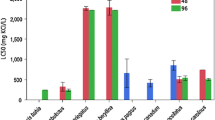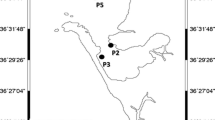Abstract
In July, 1986 the Johns Hopkins University Applied Physics Laboratory's Aquatic Ecology Section established a bioassay facility for conducting an effluent biomonitoring program for the State of Maryland. Acute toxicity test procedures were developed and implemented for testing freshwater (Pimephales promelas, Daphnia magna and Ceriodaphnia sp.) and estuarine (Cyprinodon variegatus and Mysidopsis bahia) invertebrates and fish. Procedures and test species are similar to those used by the U.S. Environmental Protection Agency (EPA) except that low salinity testing (⩽ 15‰) is conducted with the sheepshead minnow and an estuarine mysid found in the Chesapeake Bay.
Results from the first year of the program involving acute screening bioassays of major industrial and municipal dischargers are presented. Over 90 dischargers were tested during the first full year of operation. The frequency of toxicity was 36% and 14% for industrial and municipal dischargers, respectively. Reference toxicity test results are also summarized. Results from these tests are presented by outfall type. A number of examples are presented concerning the use of these data for regulating toxic discharges by the State of Maryland's Department of the Environment. These results indicate the importance of implementing a biomonitoring program with proven, easily managed methods that can be readily understood by both regulators and permit holders.
Similar content being viewed by others
References
Sprague, J. B., 1973. The ABC's of pollutant bioassay using fish. In; J. Cairns, Jr. & K. L. Dickson (eds.). Biological Methods for the Assessment of Water Quality. ASTM Spec. Tech. Publ. 528, Amer. Soc. Testing Materials. Philadelphia. pp. 6–30.
USEPA, 1984. Policy for the Development of Water Quality-Based Permit Limitations for Toxic Pollutants. 49 Federal Register, Friday, March 9, 1984, pp. 9016–9010.
USEPA, 1985. Methods for measuring the acute toxicity of effluents to freshwater and marine organisms. 3rd. ed. Environmental Monitoring and Support Laboratory, U. S. Environmental Protection Agency, Cincinnati, Ohio. EPA 600/4–85–013, 216 pp.
Williamson, R. L., Jr. & D. T. Burton, 1987. Use of aquatic biological testing under the NPDES permit system to reduce toxic pollution of the Chesapeake Bay. In; S. K. Majumdar, L. W. Hall, Jr. & H. M. Austin (eds.). Contaminant Problems and Management of Living Chesapeake Bay Resources. The Pennsylvania Academy of Science. Easton. pp. 518–540.
Author information
Authors and Affiliations
Rights and permissions
About this article
Cite this article
Fisher, D.J., Hersh, C.M., Paulson, R.L. et al. Acute toxicity of industrial and municipal effluents in the state of Maryland, USA: results from one year of toxicity testing. Hydrobiologia 188, 641–648 (1989). https://doi.org/10.1007/BF00027832
Issue Date:
DOI: https://doi.org/10.1007/BF00027832




